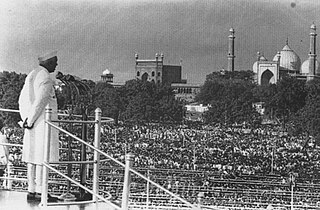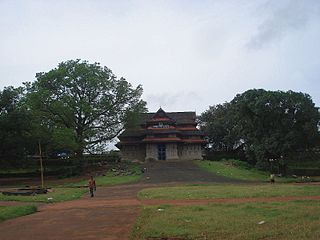The following is a list of international prime ministerial trips made by Jawaharlal Nehru during his tenure as the Prime Minister of India from 1947 to 1964.

Jawaharlal Nehru was an Indian anti-colonial nationalist, secular humanist, social democrat and author who was a central figure in India during the middle of the 20th century. Nehru was a principal leader of the Indian nationalist movement in the 1930s and 1940s. Upon India's independence in 1947, he served as the country's prime minister for 16 years. Nehru promoted parliamentary democracy, secularism, and science and technology during the 1950s, powerfully influencing India's arc as a modern nation. In international affairs, he steered India clear of the two blocs of the Cold War. A well-regarded author, his books written in prison, such as Letters from a Father to His Daughter (1929), An Autobiography (1936) and The Discovery of India (1946), have been read around the world. During his lifetime, the honorific Pandit was commonly applied before his name in India and even today too.

The prime minister of India is the head of government of the Republic of India. Executive authority is vested in the prime minister and their chosen Council of Ministers, despite the president of India being the nominal head of the executive. The prime minister is often the leader of the party or the coalition with a majority in the lower house of the Parliament of India, the Lok Sabha, which is the main legislative body in the Republic of India. The prime minister and their cabinet are at all times responsible to the Lok Sabha.

The Indian National Congress (INC), colloquially the Congress Party but often simply the Congress, is a political party in India with widespread roots. Founded in 1885, it was the first modern nationalist movement to emerge in the British Empire in Asia and Africa. From the late 19th century, and especially after 1920, under the leadership of Mahatma Gandhi, the Congress became the principal leader of the Indian independence movement. The Congress led India to independence from the United Kingdom, and significantly influenced other anti-colonial nationalist movements in the British Empire.

Morarji Ranchhodji Desai was an Indian independence activist and politician who served as the 4th Prime Minister of India between 1977 to 1979 leading the government formed by the Janata Party. During his long career in politics, he held many important posts in government such as Chief Minister of Bombay State, Home Minister, Finance Minister and 2nd Deputy Prime Minister of India.

Narendra Damodardas Modi is an Indian politician serving as the 14th and current Prime Minister of India since 2014. Modi was the Chief Minister of Gujarat from 2001 to 2014 and is the Member of Parliament from Varanasi. He is a member of the Bharatiya Janata Party (BJP) and of the Rashtriya Swayamsevak Sangh (RSS), a right-wing Hindu nationalist paramilitary volunteer organisation. He is the longest serving prime minister from outside the Indian National Congress.

The history of independent India began when the country became an independent nation within the British Commonwealth on 15 August 1947. Direct administration by the British, which began in 1858, affected a political and economic unification of the subcontinent. When British rule came to an end in 1947, the subcontinent was partitioned along religious lines into two separate countries—India, with a majority of Hindus, and Pakistan, with a majority of Muslims. Concurrently the Muslim-majority northwest and east of British India was separated into the Dominion of Pakistan, by the Partition of India. The partition led to a population transfer of more than 10 million people between India and Pakistan and the death of about one million people. Indian National Congress leader Jawaharlal Nehru became the first Prime Minister of India, but the leader most associated with the independence struggle, Mahatma Gandhi, accepted no office. The constitution adopted in 1950 made India a democratic country, and this democracy has been sustained since then. India's sustained democratic freedoms are unique among the world's newly independent states.

Gandhi Maidan is a historic ground in Patna, near the banks of the Ganges River, in Bihar, India. The Golghar falls to its west. During the period of 1824–1833, under British rule, it was used as a golf course and horse racing track and was called Patna Lawns. It is spread across 60 acres of land.

The bilateral relations between the Himalayan Kingdom of Bhutan and the Republic of India have been traditionally close and both countries share a "special relationship", making Bhutan a protected state, but not a protectorate, of India. India remains influential over Bhutan's foreign policy, defence and commerce. Bhutan is the largest beneficiary of India's foreign aid.

Mexico–India relations, also called Mexican-Indian relations or Indo-Mexican relations, are the diplomatic relations between India and Mexico. Both nations are members of the G-20 major economies and the United Nations.

Thekkinkadu Maidanam is situated in the middle of Thrissur city of Kerala state in India. This hillock which seats the Vadakkumnathan Temple, is an open ground in the centre of the Thrissur city which is under the custody of the Cochin Devaswom Board (CDB). It hosts the spectacular cultural festival Thrissur Pooram, which is considered the Mother of all Poorams in Kerala.

The most significant initiative made by the Narendra Modi government is the focus on neighbouring countries and major Asian powers coupled with emphasizing on the two decades old Look East policy. Asia being the major focus area of his foreign policy, Modi and his foreign minister chose several Asian countries for their initial bilateral visits. He has made state visits to Bhutan and Nepal and Japan within the first 100 days of his government and also hosted Asian leaders like former Prime Minister Tony Abbott of Australia, President Xi Jinping of China and Prime Minister Nguyễn Tấn Dũng of Vietnam, apart from inviting SAARC leaders in his inauguration ceremony. External Affairs Minister Sushma Swaraj has also made official visits to several Asian capitals like Dhaka, Bangladesh, Kathmandu, Nepal, Naypidaw, Myanmar, Singapore, Hanoi, Vietnam, Manama, Bahrain, Kabul, Afghanistan, Dushanbe, Tajikistan, Malé, Maldives, Abu Dhabi, United Arab Emirates, Seoul, South Korea and Beijing China.

Neighbourhood First Policy of India, a core component of India's foreign policy, focuses on peaceful relations and collaborative synergetic co-development with its South Asian neighbors of the Indian subcontinent encompassing a diverse range of topics, such as economic, technology, research and education, connectivity, space program, defence security, environment and climate challenge. This policy creates new avenues as well as leverages existing regional cooperation initiatives, such as SAARC, SASEC, BBIN, and BIMSTEC. It compliments India's Look East policy focused on Southeast Asia and Look West Policy focused on Middle East.

India–Sweden relations are the bilateral ties between India and Sweden. Sweden recognised India's independence from the United Kingdom in 1947; both nations established formal diplomatic relations in 1949. India has an embassy in Stockholm, while Sweden has an embassy in New Delhi and honorary consulates in Chennai, Kolkata and Mumbai.

The Principal Secretary to the Prime Minister of India is the senior-most bureaucrat in, and the administrative head of, the Prime Minister's Office. The officeholder is generally a civil servant, commonly from the Indian Administrative Service and occasionally from the Indian Foreign Service. The post is considered one of the most influential in the Indian civil services, and some principal secretaries are considered more powerful and influential than senior government ministers.
The History of Indian foreign policy refers to the foreign relations of modern India post-independence, that is the Dominion of India (from 1947 to 1950) and the Republic of India (from 1950 onwards).

India–Yugoslavia relations were historical foreign relations between India and now split-up Socialist Federal Republic of Yugoslavia. Yugoslavia established full diplomatic relations with India on 5 December 1948 following the 1948 Tito–Stalin split. Initially two countries developed their relations at the UN Security Council in 1949 during their shared membership. In the period of the Cold War both countries were the founders and among core members of the Non-Aligned Movement.